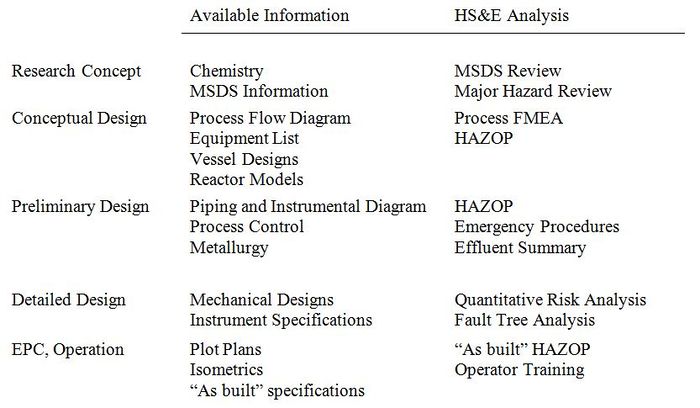Process safety
Title: Process Safety
Authors: Anne Disabato, Tim Hanrahan, Brian Merkle
Date Presented: January 19, 2014
Introduction
The safe design and operation of facilities is of paramount importance to every company that is involved in the manufacture of fuels, chemicals, and pharmaceuticals. Process safety focuses on the prevention of dangerous situations, such as fires, explosions, and the release of chemicals.
The American Institute of Chemical Engineers emphasizes a culture of process safety through four pillars:
1. Commitment to Process Safety: a workforce that is actively involved and an organization that fully supports process safety as a core value will tend to do the right things in the right way at the right time – even when no one else is looking
2. Understanding Hazard and Risk: the foundation of a risk-based approach which will allow an organization to use this information to allocate limited resources in the most effective manner
3. Manage Risk: the ongoing execution of risk based process safety tasks. Risk management can help a company to better deal with the resultant risks and sustain long-term accident free and profitable operations
4. Learn from Experience: Metrics provide direct feedback on the workings of RBPS systems, and leading indicators provide early warning signals of ineffective process safety results. Organizations must use their mistakes and those of others as motivation for action and view as opportunities for improvement.
Safety Organizations and Terminology
Organizations
OSHA
The Occupational Safety and Health Administration (OSHA) is a federal agency that focuses on the enforcement of safety and health legislation.
EPA
The Environmental Protection Agency (EPA) is a U.S. agency whose purpose is the protection of the health of both humans and the environment through the writing and enforcement of regulatory laws.
DOT
The Department of Transportation (DOT) oversees federal highway, air, and maritime transportation.
DOE
The Department of Energy (DOE) is a governmental department tasked with the advancement of energy technology in the United States.
Terminology
HS&E - Health, Safety, and Environmental
MSDS - Material Safety and Data Sheet
FMEA - Failure Mode and Effects Analysis
HAZOP - Hazard and Operability Study
Safe Design
Inherently Safe Design
Inherently safe design of a particular process can be achieved by adhering to the following six strategies put forth by Turton et al:
1. Substitution: Avoid using or producing hazardous materials on the plant site. If the hazardous material is an intermediate product, for example, alternate chemical reaction pathways might be used. In other words, the most inherently safe strategy is to avoid the use of hazardous materials.
2. Intensification: Attempt to use less of the hazardous materials. In terms of a hazardous intermediate, the two processes could be more closely coupled, reducing or eliminating the amount of intermediate produced. The inventories of hazardous feeds or products can be reduced by enhanced scheduling techniques such as just-in-time (JIT) manufacturing.
3. Attenuation: Reducing, or attenuating, the hazards of materials can often be affected by lowering the temperature or adding stabilizing additives. By using materials under less hazardous conditions, the potential consequences of a leak can be reduced.
4. Containment: If the hazardous materials cannot be eliminated, they at least should be stored in vessels with mechanical integrity beyond any reasonably expected temperature or pressure excursion. This is an old but effective strategy to avoid leaks. However, it is not as inherently safe as substitution, intensification, or attenuation.
5. Control: If a leak of hazardous material does occur, there should be safety systems that reduce the effects. For example, chemical facilities often have emergency isolation of the site from the normal storm sewers, and large tanks for flammable liquids are surrounded by dikes that prevent any leaks from spreading to to other areas of the plant. Scrubbing systems and relief systems in general are in this category. They are essential, because they allow controlled, safe release of hazardous materials, rather than an uncontrolled release from a vessel rupture.
6. Survival: If leaks of hazardous materials do occur and they are not contained or controlled, the personnel (and the equipment) must be protected. This lowest level of the hierarchy includes fire fighting, gas masks, and so on. Although essential to the total safety of the plant, the greater the reliance on survival of leaks rather than elimination of leaks, the less inherently safe the facility.
Assessing Preliminary Design
While pilot plants are necessary to design effective plant equipment, there are some dangers associated with the industrial scale of chemical plants. Scaling up without accurate literature and experimental data can be very dangerous.
In every step of process design, the Health, Safety, and Environmental (HS&E) analysis must be carried out with the available technical information.
References
1. American Institute of Chemical Engineers. http://www.aiche.org/ccps
2. R.T. Turton, R.C. Bailie, W.B. Whiting, J.A. Shaeiwitz, Analysis, Synthesis, and Design of Chemical Processes, Prentice Hall: Upper Saddle River, 2003.

